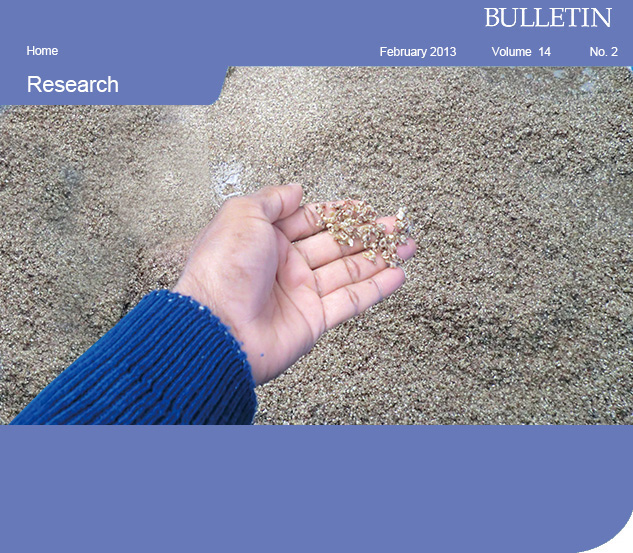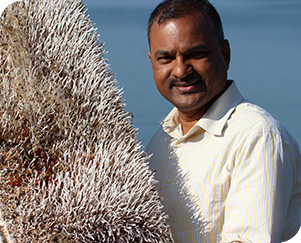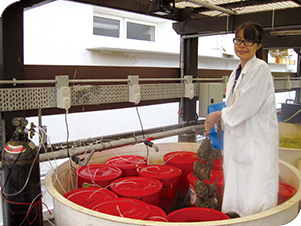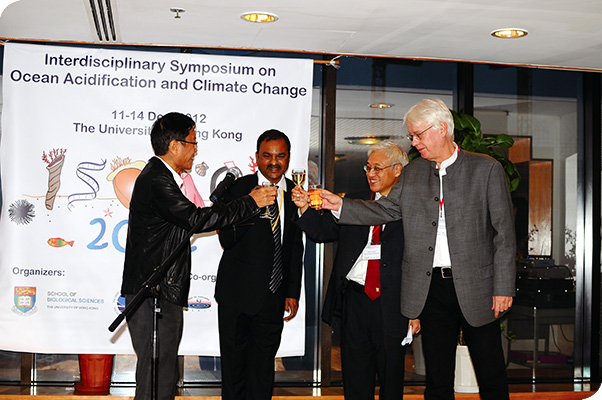| Tube Worms, Oysters and the Contingency of Seawater Chemistry |
|
| Ocean acidification drives a complex dance of survival for two marine species. |

|
Down on its rocky outcrop at Cape D’Aguilar, the Swire Institute of Marine Science (SWIMS) and the School of Biological Sciences continue its research on the effects of rising CO2 levels on marine life. Two species currently receiving the close attention of Dr V Thiyagarajan (Rajan) and his team are held in rather different regard by human beings. One is the oyster, particularly the Hong Kong oyster, which is a benign and tasty creature. The other is the smaller and more obscure tube worm which Dr Rajan calls, quite simply, ‘a troublemaker’. The tube worm, hydroides elegans, is a warm water biofouler operating in Hong Kong at the upper limit of its area and it is under threat. Dr Rajan’s team recently published a paper in PLoS ONE entitled ‘The CO2-Driven Ocean Acidification Alters and Weakens Integrity of the Calcareous Tubes Produced by the Serpulid Tubeworm, Hydroides elegans’. The ‘troublemaker’ Shipowners, hoteliers and other institutions that use piped-in seawater as air conditioning cooler will be applauding that news. The tube worm attaches itself in dense clusters to ships’ hulls, which causes drag, and to the insides of seawater pipes, blocking flow. As larvae, these fingernail length creatures cling to surfaces, draw calcium carbonate from the water and go through a process of biomaterialisation, forming protective shells. No one knows quite what cues them to make these attachments, though they favour certain balanced water flows, which ships and pipes afford. The paper’s findings make it clear that the ocean acidification (OA) caused by increased carbon dioxide weakens the formation of tube worm shells. These are composed mostly of highly soluble calcium carbonate (CaCO3), aragonite, with a smaller proportion of an even more soluble, amorphous precursor version of CaCO3, ACC. Acidification provokes the formation of excessive ACC, changing the ratio to aragonite proper and fatally weakening the shell. For Dr Rajan, the downside of the reduction or extinction of tube worms is an inevitable damage to biodiversity in the ocean. The tube worm clusters are dense. They are similar in effect to coral reefs and the value of a coral reef, he says, is not in the coral itself but the community that lives within it. In a lesser but important way, the tube worms support a community of small sea animals and these will be lost with the worms. |
 |
“The preliminary look suggests that our system is different to other coastal waters but different in a bad way.”
|
||
| Dr V Thiyagarajan |
|
Different in a bad way
Dr Rajan makes the important point that Hong Kong waters have probably the highest levels and fastest growth of carbon dioxide in the world. “The preliminary look suggests that our system is different to other coastal waters, but different in a bad way.” he says. “We need huge research input into this field. That has to be established strongly.” He says we need to identify how much of the change is due to the geography of Hong Kong, to Pearl River outflow and to human CO2. In an article in the December 2011 edition of Bulletin, Dr Rajan explained how the change of carbonate chemistry in local seawaters was also affecting oyster shell formation and threatening the |
 The oyster larval culture (mini-experimental hatchery) facility for HKU students to study climate change effects on oysters |
| death of a delicacy. “Since then, we have done a lot of work and garnered resources,” he says. The Hong Kong Government and the University of Hong Kong have paid enormous attention to this issue and funded several projects worth over HK$10 million to Dr Rajan and his international interdisciplinary research group, comprised mostly of PhD graduates. |
|
‘How many more Christmases for oysters?’ In December 2012, the Institute called together a meeting of 20 leading marine scientists from 12 countries and graduate students from Hong Kong universities to discuss the problem of OA and explore solutions. Titled ‘Interdisciplinary Symposium on Ocean Acidification and Climate Change’ (ISOACC), they issued a press release headed, ‘How many more Christmases for oysters?’ and made some significant points. If the impact of high partial pressure of carbon dioxide (pCO2) on our marine ecosystem goes unnoticed, we may start losing oyster species very soon. This will have severe economic and social consequences, not only in China and Hong Kong, but also globally because China currently produces over 80 per cent of the world’s oysters. Hong Kong has just banned bottom trawling and the government will try to boost aquaculture and maricultural activities to reemploy fishermen. As these strongly depend on our seawater chemistry and We need to map the cause and effects of local chemistry changes and look into possible solutions including coastal zone management such as blue carbon. The ISOACC discussed several possible options, one of which is to identify an oyster population that can withstand high pCO2 seawater and selectively breed them in aquaculture forms. Dr Rajan explained that there are three regional oysters, the Japanese, the Xiamen and the Hong Kong. The most likely to survive was the more invasive Japanese oyster. The larger, fleshier Hong Kong Dr Rajan believes that awareness of the Hong Kong oyster, caught not so much at Lau Fau Shan but along the Chinese coast, should be raised locally. Most people in Hong Kong do not know about it or eat it. “Marketed effectively, a sustainable way of culturing the oyster could be found and more use made of it,” says Dr Rajan. |
 From right: Professor David Dudgeon, Associate Dean of Faculty of Science, Professor Paul Tam, Pro-Vice-Chancellor, Dr V Thiyagarajan and Professor Rudolf Wu, Director of School of Biological Sciences, made the opening toast at the 1st ISOACC. |
| Back | Next |